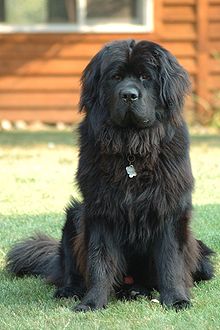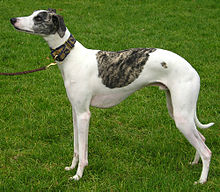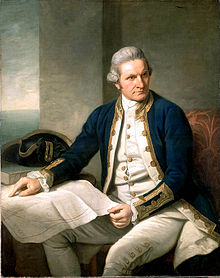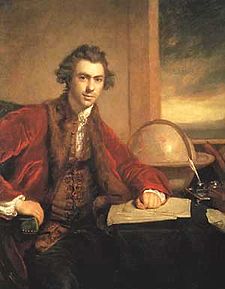In 1766 James Cook was commissioned as Captain of the HM Bark Endeavour for the first of three voyages of discovery to the Pacific. He was first to observe the transit of Venus from Tahiti. He arrived on the 13th April 1769, and observed the transit, then opened sealed orders which required him to search for a southern continent. Cook reached New Zealand travelling westward and sighter "Young Nick's (Nick Young's) Head in September 1769.
The story has been fairly well told, so there is no need to go over most of the details, but it was Bank's intention, since he had the money and the connections, to make it his voyage. From the start he was disagreeable and tried to throw his weight around. Later in his career he connected up with Bligh, who was on the third voyage, but that is another story.
The dicipline problem was easily solved. Scurvey was a problem on long voyages at sea, but Cook (I) understood that it had something to do with greens, and fresh vegetables. Therefore there was a good quantity of lemons on board. Some of the crew were not happy eating greens, and preferred ships biscuits and some pickled meat, and beer of course. Since I had the luxury of being more than one soul, I had some reliable crew on board. One man (I) refused to eat his greens, so I made an example of him to intimidate the crew. 39 lashes with the cat-o -9s was the maximum penalty the admiralty allowed, so after that, which was no punishment at all compared to the 500 and "whipped around the fleet" that used to be the punishment of the navy, everybody willingly ate their food.
Banks was not such a good sailor though, and spent a lot of his time below decks with his companions drinking beer and getting drunk, as the journals record. next page


The Whippet is a breed of dog in the sighthound family. They are active and playful and are physically similar to a small Greyhound.
Whippets were bred to hunt by sight, coursing game in open areas at high speeds. One can find numerous representations of small greyhound-like hounds in art dating back to Roman times but the first written English use of the word "whippet" with regard to a type of dog was in 1610.[13] There is a picture by Jean Baptiste Oudry (1686–1755) of "Misse", one of two English whippets presented to Louis XV, in the Washington National Gallery and another, with her companion, "Turlu", by the same artist in the Musée National de Fontainebleau. However, some French sources, notably the Ministry of Culture, use the word "levrette" to describe Misse and Turlu. Levrette describes small greyhound type dogs like the whippet or the Italian greyhound. In the nineteenth century, whippet racing was a national sport in England, more popular than football. It is only beginning with this period that the existence of the whippet as a distinct breed can be stated with certainty. The age of the modern whippet dawned in 1890 when the English Kennel Club granted the breed official recognition, thus making the whippet eligible for competition in dog shows, and commencing the recording of their pedigrees. In the United States, the whippet was recognized in 1888 by the American Kennel Club. Early specimens were taken from the race track by dog fanciers of the time and exported all over the world. The whippet's versatility as a hunting, racing, exhibition or companion dog soon made it one of the most popular of the sighthound breeds.

Captain James Cook, FRS, RN (7 November 1728[NB 1] – 14 February 1779) was a British explorer, navigator and cartographer who ultimately rose to the rank of captain in the Royal Navy. Cook made detailed maps of Newfoundland prior to making three voyages to the Pacific Ocean, during which he achieved the first European contact with the eastern coastline of Australia and the Hawaiian Islands, as well as the first recorded circumnavigation of New Zealand.
Cook joined the British merchant navy as a teenager and joined the Royal Navy in 1755. He saw action in the Seven Years' War, and subsequently surveyed and mapped much of the entrance to the Saint Lawrence River during the siege of Quebec. This helped bring Cook to the attention of the Admiralty and Royal Society. This notice came at a crucial moment in both Cook's career and the direction of British overseas exploration, and led to his commission in 1766 as commander of HM Bark Endeavour for the first of three Pacific voyages.
On June 3, 1769, British navigator, Captain James Cook, British astronomer Charles Green and Swedish naturalist Daniel Solander observed and recorded the transit of Venus on the island of Tahiti during Cook’s first voyage around the world.[1] During a transit, Venus appears as a small black disc travelling across the Sun. This unusual astronomical phenomenon takes place in a pattern that repeats itself every 243 years. It includes two transits that are eight years apart, separated by breaks of 121.5 and 105.5 years.[2] These men, along with a crew of scientists, were commissioned by the Royal Society of London for the primary purpose of viewing the transit of Venus. Not only would their findings help expand scientific knowledge, it would help with navigation by accurately calculating the observer’s longitude. At this time, longitude was difficult to determine and not always precise.[3] A “secret” mission that followed the transit included the exploration of the South Pacific to find the legendary Terra Australis Incognita or “unknown land of the South.”[4]
Transit of Venus
In 1766, the Royal Society engaged Cook to travel to the Pacific Ocean to observe and record the transit of Venus across the Sun. Cook, at the age of 39, was promoted to lieutenant and named as commander of the expedition.[15][16] The expedition sailed from England in 1768, rounded Cape Horn and continued westward across the Pacific to arrive at Tahiti on 13 April 1769, where the observations of the Venus Transit was made. However, the result of the observations was not as conclusive or accurate as had been hoped. Once the observations were completed, Cook opened the sealed orders which were additional instructions from the Admiralty for the second part of his voyage: to search the south Pacific for signs of the postulated rich southern continent of Terra Australis.[17] Cook later mapped the complete New Zealand coastline, making only some minor errors. He then sailed west, reaching the south-eastern coast of the Australian continent on 19 April 1770, and in doing so his expedition became the first recorded Europeans to have encountered its eastern coastline.[NB 2]

Joseph Banks, as painted by Sir Joshua Reynolds in 1773.
Sir Joseph Banks, 1st Baronet, GCB, PRS (24 February [O.S. 13 February] 1743 – 19 June 1820)[1] was an English naturalist, botanist and patron of the natural sciences. He took part in Captain James Cook's first great voyage (1768–1771).[2] Banks is credited with the introduction to the Western world of eucalyptus, acacia, mimosa and the genus named after him, Banksia. Approximately 80 species of plants bear Banks's name. Banks was also the leading founder of the African Association, a British organization dedicated to the exploration of Africa, and a member of the Society of Dilettanti, which helped to establish the Royal Academy.
Banks was promptly appointed to a joint Royal Navy/Royal Society scientific expedition to the south Pacific Ocean on HM Bark Endeavour, 1768–1771. This was the first of James Cook's voyages of discovery in that region. This voyage went to Brazil, where Banks made the first scientific description of a now common garden plant, bougainvillea (named after Cook's French counterpart, Louis Antoine de Bougainville), and to other parts of South America. The voyage then progressed to Tahiti (where the transit of Venus was observed, the overt purpose of the mission), to New Zealand and to the east coast of Australia, where Cook mapped the coastline and made landfall at Botany Bay and at Endeavour River (near modern Cooktown) in Queensland, where they spent almost seven weeks ashore while the ship was repaired after foundering on the Great Barrier Reef.[7] While they were in Australia Banks, the Swedish botanist Daniel Solander and the Finnish botanist Dr. Herman Spöring Jr. made the first major collection of Australian flora, describing many species new to science. Almost 800 specimens were illustrated by the artist Sydney Parkinson and appear in Banks' Florilegium, finally published in 35 volumes between 1980 and 1990.
The Royal Academy of Arts is an art institution based in Burlington House on Piccadilly, London. The Royal Academy of Arts has a unique position in being an independent, privately funded institution led by eminent artists and architects whose purpose is to promote the creation, enjoyment and appreciation of the visual arts through exhibitions, education and debate.
| 1769 Nov 9 | 23:09 | Observed by Charles Green and James Cook from Mercury Bay in New Zealand.[6] Noted that Mercury had little or no atmosphere. |